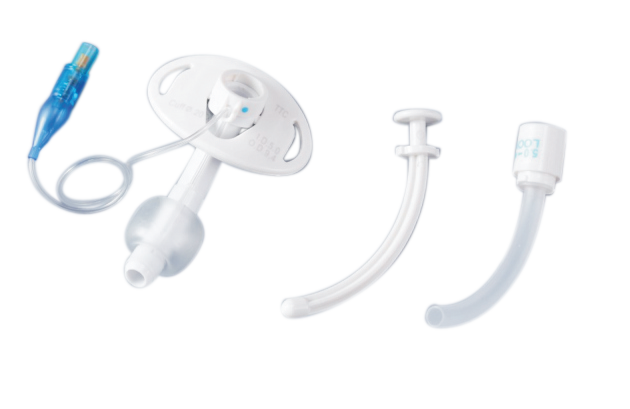
A tracheostomy is a medical procedure that involves making an incision in the neck in order to insert a breathing tube into the windpipe. The inner cannula fits inside the outer cannula. It has a lock to keep it from being coughed out, and it is removed for cleaning. The obturator is used to insert a tracheostomy tube. It fits inside the tube to provide a smooth surface that guides the tracheostomy tube when it is being inserted.
| Ref. No.: | Size: | Qty. Cs: |
|---|---|---|
| NMR100732 | 5.0 | 100 |
| NMR100737 | 6.5 | 100 |
| NMR100742 | 7.0 | 100 |
A tracheostomy is a medical procedure that involves making an incision in the neck in order to insert a breathing tube into the windpipe.
A tracheostomy tube with inner cannula is a type of artificial airway that is inserted through an incision in the neck and into the trachea (windpipe). The outer cannula is used to keep the airway open, and the inner cannula is used to breathe through. This type of breathing tube is typically used when someone has a blockage in their airway or if they are unable to breathe on their own.
There are different types of tracheostomy tubes, each with their own benefits and drawbacks. The most common type of tube is the cuffed tube. This type of tube has a cuff that inflated to seal off the trachea from the rest of the respiratory system. This helps to prevent infection and prevents secretions from entering the lungs. However, the cuff can also put pressure on the trachea, which can be uncomfortable for some patients.
Another type of tube is the uncuffed tube. This type of tube does not have a cuff, so there is no risk of it damaging the trachea. However, because there is no cuff, secretions can more easily enter the lungs, which increases the risk of infection.
Some tubes have an inner cannula, which is a smaller tube that goes inside the main tube. The inner cannula can be removed and replaced without having to remove the entire tracheostomy tube. This is helpful if the patient needs to have their tracheostomy tube replaced frequently. However, it is important to make sure that the inner cannula is clean and sterile before inserting it into the patient's airway.
When it comes to tracheostomy tubes, there are both pros and cons that need to be considered. This is a vital decision that should be made with the help of a medical professional, as they will be able to best advise you on which tube will be right for your individual needs. With that said, let’s take a closer look at some of the pros and cons of tracheostomy tubes.
Pros:
Allows for easier breathing: One of the biggest advantages of a tracheostomy tube is that it can help to make breathing easier. This is especially important for those who have difficulty breathing due to an obstruction in their airway.
Can be used as a long-term solution: Another pro is that a tracheostomy tube can be used as a long-term solution, if necessary. This means that you won’t have to worry about the tube falling out or needing to be replaced frequently.
Cons:
Risk of infection: One of the main disadvantages of a tracheostomy tube is the risk of infection. This is because the tube creates an opening in your throat, which can allow bacteria to enter your body.
A tracheostomy tube is a small tube that is inserted through a hole in the neck into the trachea (windpipe). The tube is held in place with a tape or strap around the neck. A tracheostomy tube is used when there is a blockage of the airway or to help with breathing.
The care of a tracheostomy tube is very important. It is important to keep the area around the tracheostomy clean and free from infection. The skin around the stoma (hole) should be cleaned every day with soap and water. The health care provider will show you how to clean the tracheostomy tube and change the inner cannula (tube).
It is important to check the skin around the stoma every day for redness, swelling, or drainage. These are signs of infection. Call your health care provider if you see any of these signs.
The trach tube should be checked often to make sure it is in the correct position and is not blocked. If it becomes blocked, remove the obturator (curved metal rod) and suction any mucus from around the inner cannula.
The most common reason to replace a tracheostomy tube is because the inner cannula has become blocked. This can happen if secretions build up around the cannula or if the cannula becomes kinked. If the inner cannula becomes blocked, it will need to be replaced in order to ensure that the person can continue to breathe properly.
Another reason to replace a tracheostomy tube is if it becomes worn out or damaged. Over time, the tubing can become brittle and break. Additionally, the cuff on the tracheostomy tube can leak air, which can lead to difficulty breathing. If either of these problems occur, it will be necessary to replace the tracheostomy tube.